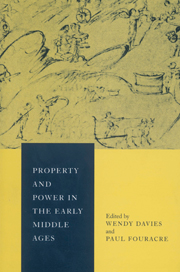Book contents
- Frontmatter
- Contents
- List of maps
- Preface
- List of abbreviations
- Introduction
- 1 The ideology of sharing: apostolic community and ecclesiastical property in the early middle ages
- 2 Teutsind, Witlaic and the history of Merovingian precaria
- 3 Eternal light and earthly needs: practical aspects of the development of Frankish immunities
- 4 The wary widow
- 5 Lordship and justice in the early English kingdom: Oswaldslow revisited
- 6 Adding insult to injury: power, property and immunities in early medieval Wales
- 7 Property transactions and social relations between rulers, bishops and nobles in early eleventh-century Saxony: the evidence of the Vita Meinwerci
- 8 Monastic exemptions in tenth- and eleventh-century Byzantium
- 9 Property ownership and signorial power in twelfth-century Tuscany
- 10 Conclusion: property and power in early medieval Europe
- Glossary
- List of works cited
- Index
2 - Teutsind, Witlaic and the history of Merovingian precaria
Published online by Cambridge University Press: 25 January 2010
- Frontmatter
- Contents
- List of maps
- Preface
- List of abbreviations
- Introduction
- 1 The ideology of sharing: apostolic community and ecclesiastical property in the early middle ages
- 2 Teutsind, Witlaic and the history of Merovingian precaria
- 3 Eternal light and earthly needs: practical aspects of the development of Frankish immunities
- 4 The wary widow
- 5 Lordship and justice in the early English kingdom: Oswaldslow revisited
- 6 Adding insult to injury: power, property and immunities in early medieval Wales
- 7 Property transactions and social relations between rulers, bishops and nobles in early eleventh-century Saxony: the evidence of the Vita Meinwerci
- 8 Monastic exemptions in tenth- and eleventh-century Byzantium
- 9 Property ownership and signorial power in twelfth-century Tuscany
- 10 Conclusion: property and power in early medieval Europe
- Glossary
- List of works cited
- Index
Summary
The history of the transfer of power from the Merovingians to the Carolingians has been seen in part as a history of the transfer of land. The Merovingians supposedly alienated much of their property, including such favoured villas as Clichy, while the Pippinid ancestors of the Carolingians built a landed power-base from which to expand their authority over the whole of Francia. This powerbase was increased dramatically by Charles Martel's seizure of land, largely from the church, and its alienation, whether in grants of property or in precaria, that is effectively of usufruct, to his followers.
As a broad sketch of the issues this reconstruction has much to commend it, but it does demand so many caveats that it can only mislead all but the best informed. To begin with the question of the Merovingian alienation of land; certainly this took place. What is not known is the extent to which the losses were counterbalanced by gains. Kings alienated land to secure support, but they also received land from those without heirs and by means of confiscation. Charters, which provide the majority of our evidence on royal wealth, only talk about alienation; rarely, if ever, about acquisition. As for the supposed status of the land alienated, who is to say whether a villa like Clichy, favoured by one king, was liked by his descendants?
The Pippinid acquisition of land is less questionable. Yet the precise mechanisms by which the Pippinids acquired their land suggest that something much more complex was at stake than the steady creation of a power-base by one lineage.
- Type
- Chapter
- Information
- Property and Power in the Early Middle Ages , pp. 31 - 52Publisher: Cambridge University PressPrint publication year: 1995
- 7
- Cited by



